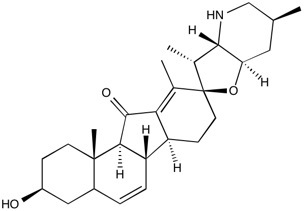Jervine | Hedgehog pathway inhibitor
NMR (Conforms)

Available Options
| Size : | Price | Quantity | |
|---|---|---|---|
| 5 mg | $85.00 | ||
| 25 mg | $340.00 |
Jervine (469-59-0) is an inhibitor of Hedgehog signaling (IC50 = 0.5-0.7 μM). Binds directly to Smoothened (Smo).1 Inhibits the response of target tissues to Sonic hedgehog signaling.2 Jervine induces COX-2 overexpression in human erythroleukemia cells.3
References/Citations:
1) Cooper et al. (1998), Teratogen-mediated inhibition of target tissue response to Shh signaling; Science, 280 1603
2) Mistretta et al. (2003), Cyclopamine and jervine in embryonic rat tongue cultures demonstrate a role for Shh signaling in taste papilla development and patterning: fungiform papillae double in number and form in novel locations in dorsal lingual epithelium; Dev. Biol., 254 1
3) Ghezale et al. (2013), Cyclopamine and jervine induce COX-2 overexpression in human erythroleukemia cells but only cyclopamine has a pro-apoptotic effect; Exp. Cell Res., 319 1043
NMR (Conforms)
Safety Data Sheet:
Product Data Sheet:
Materials provided by Focus Biomolecules are for laboratory research use only and are not intended for human or veterinary applications. Please note that we do not sell to individuals and that all orders placed by non-research organizations will incur a $20 restocking/refund fee
Jervine (469-59-0) is an inhibitor of Hedgehog signaling (IC50 = 0.5-0.7 μM). Binds directly to Smoothened (Smo).1 Inhibits the response of target tissues to Sonic hedgehog signaling.2 Jervine induces COX-2 overexpression in human erythroleukemia cells.3
References/Citations:
1) Cooper et al. (1998), Teratogen-mediated inhibition of target tissue response to Shh signaling; Science, 280 1603
2) Mistretta et al. (2003), Cyclopamine and jervine in embryonic rat tongue cultures demonstrate a role for Shh signaling in taste papilla development and patterning: fungiform papillae double in number and form in novel locations in dorsal lingual epithelium; Dev. Biol., 254 1
3) Ghezale et al. (2013), Cyclopamine and jervine induce COX-2 overexpression in human erythroleukemia cells but only cyclopamine has a pro-apoptotic effect; Exp. Cell Res., 319 1043
Related Hedgehog Pathway Products
Download
Calculate the molar concentration, mass or volume in a solution.
Concentration × Volume × Molecular Weight = Mass
Focus Biomolecules • Plymouth Meeting, PA USA • 1-855-FOCUS21
Focus Biomolecules
Plymouth Meeting, PA USA
1-855-FOCUS21
Website Created by Advanta Advertising LLC.

